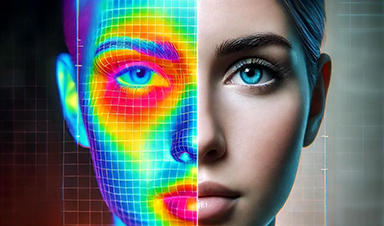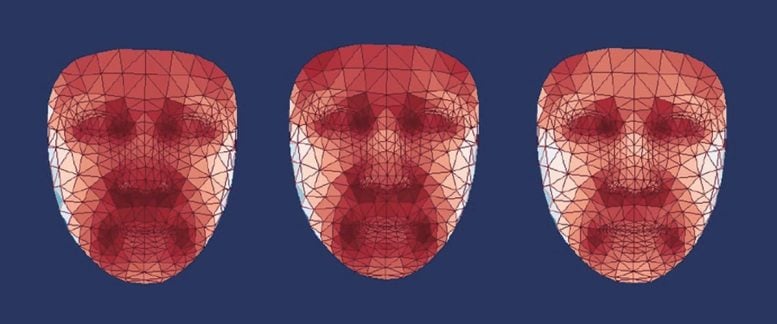Researchers have found that different facial temperatures correlate with chronic illnesses like diabetes and high blood pressure, and these can be detected using AI with thermal cameras.
They highlight the potential of this technology for promoting healthy aging by using thermal facial imaging to predict a person’s health status and biological age. The study also found that regular physical activities like jumping rope can decrease one’s thermal age, suggesting a possible link between exercise and thermal signs of aging.
A colder nose and warmer cheeks may be a telltale sign of rising blood pressure.
Researchers discovered that temperatures in different face regions are associated with various chronic illnesses, such as diabetes and high blood pressure. These temperature differences are not easily perceptible by one’s own touch but can instead be identified using specific AI-derived spatial temperature patterns that require a thermal camera and a data-trained model. The results were published recently in the journal Cell Metabolism. With further research, doctors could one day use this simple and non-invasive approach for early detection of diseases.
Average facial temperatures of three aging-status groups among women 50-60 years old. Credit: Zhengqing Yu and Jing-Dong J Han
Potential of Thermal Facial Imaging
“Aging is a natural process,” says Jing-Dong Jackie Han, the paper’s corresponding author at Peking University in Beijing. “But our tool has the potential to promote healthy aging and help people live disease-free.”
The team had previously used 3D facial structure to predict people’s biological age, which indicates how well the body is aging. Biological age is closely related to the risk of diseases, including cancer and diabetes. They were curious if other features of the face, such as temperature, could also predict aging rate and health status.
Age and Health Indicators Through Thermal Analysis
Han and her colleagues analyzed facial temperatures of more than 2,800 Chinese participants between the ages of 21 and 88. Then, the researchers used the information to train AI models that could predict a person’s thermal age. They identified several key facial regions where the temperatures were significantly related to age and health, including the nose, eyes and cheeks.
The team found the temperature of the nose decreases with age at a rate faster than other parts of the face, meaning people with warmer noses have a younger thermal age. At the same time, temperatures around the eyes tend to increase with age.
The team also found that people with metabolic disorders such as diabetes and fatty liver disease had faster thermal aging. They tended to have higher eye area temperatures than their healthy counterparts of the same age. People with elevated blood pressure also had higher cheek temperatures.
Exploring Thermal Aging and Disease Connections
By analyzing participants’ blood samples, the team revealed that the increase in temperatures around the eyes and cheeks was mainly because of an increase in cellular activities related to inflammation, such as repairing damaged DNAs and fighting infections. The increase in these activities led to a rise in temperatures in certain facial regions.
“The thermal clock is so strongly associated with metabolic diseases that previous facial imaging models were not able to predict these conditions,” Han says.
Thermal Imaging and Physical Activity
Due to this connection, the team set out to test if exercise could influence thermal age. They asked 23 participants to jump rope for at least 800 times daily for two weeks. To the team’s surprise, these participants reduced their thermal age by five years after just two weeks of exercise.
Next, the team wants to explore if they can use thermal facial imaging to predict other diseases, such as sleeping disorders or cardiovascular problems.
“We hope to apply thermal facial imaging in clinical settings, as it holds significant potential for early disease diagnosis and intervention,” Han says.
Reference: “Thermal facial image analyses reveal quantitative hallmarks of aging and metabolic diseases” by Zhengqing Yu, Yong Zhou, Kehang Mao, Bo Pang, Kai Wang, Tang Jin, Haonan Zheng, Haotian Zhai, Yiyang Wang, Xiaohan Xu, Hongxiao Liu, Yi Wang and Jing-Dong J. Han, 2 July 2024, Cell Metabolism.
DOI: 10.1016/j.cmet.2024.05.012
This work was supported by the National Natural Science Foundation of China and the Ministry of Science and Technology of the People’s Republic of China.
News
Specially engineered antibody delivers RNA therapy to treatment-resistant tumors
Elias Quijano, PhD; Diana Martinez-Saucedo, PhD; Zaira Ianniello, PhD; and Natasha Pinto-Medici, PhD, there are 25 other contributors, most from Yale's Department of Therapeutic Radiology and from the departments of genetics, molecular biophysics and [...]
Vaccinated women face fewer cervical cancer risks
New data from Denmark shows the HPV vaccine’s powerful long-term impact, while also revealing why cervical cancer screening is still essential. A Danish study published in the journal Eurosurveillance reports that women who received the human [...]
3D-printed implant offers a potential new route to repair spinal cord injuries
A research team at RCSI University of Medicine and Health Sciences has developed a 3-D printed implant to deliver electrical stimulation to injured areas of the spinal cord, offering a potential new route to [...]
Nanocrystals Carrying Radioisotopes Offer New Hope for Cancer Treatment
The Science Scientists have developed tiny nanocrystal particles made up of isotopes of the elements lanthanum, vanadium, and oxygen for use in treating cancer. These crystals are smaller than many microbes and can carry isotopes of [...]
New Once-a-Week Shot Promises Life-Changing Relief for Parkinson’s Patients
A once-a-week shot from Australian scientists could spare people with Parkinson’s the grind of taking pills several times a day. The tiny, biodegradable gel sits under the skin and releases steady doses of two [...]
Weekly injectable drug offers hope for Parkinson’s patients
A new weekly injectable drug could transform the lives of more than eight million people living with Parkinson's disease, potentially replacing the need for multiple daily tablets. Scientists from the University of South Australia [...]
Most Plastic in the Ocean Is Invisible—And Deadly
Nanoplastics—particles smaller than a human hair—can pass through cell walls and enter the food web. New research suggest 27 million metric tons of nanoplastics are spread across just the top layer of the North [...]
Repurposed drugs could calm the immune system’s response to nanomedicine
An international study led by researchers at the University of Colorado Anschutz Medical Campus has identified a promising strategy to enhance the safety of nanomedicines, advanced therapies often used in cancer and vaccine treatments, [...]
Nano-Enhanced Hydrogel Strategies for Cartilage Repair
A recent article in Engineering describes the development of a protein-based nanocomposite hydrogel designed to deliver two therapeutic agents—dexamethasone (Dex) and kartogenin (KGN)—to support cartilage repair. The hydrogel is engineered to modulate immune responses and promote [...]
New Cancer Drug Blocks Tumors Without Debilitating Side Effects
A new drug targets RAS-PI3Kα pathways without harmful side effects. It was developed using high-performance computing and AI. A new cancer drug candidate, developed through a collaboration between Lawrence Livermore National Laboratory (LLNL), BridgeBio Oncology [...]
Scientists Are Pretty Close to Replicating the First Thing That Ever Lived
For 400 million years, a leading hypothesis claims, Earth was an “RNA World,” meaning that life must’ve first replicated from RNA before the arrival of proteins and DNA. Unfortunately, scientists have failed to find [...]
Why ‘Peniaphobia’ Is Exploding Among Young People (And Why We Should Be Concerned)
An insidious illness is taking hold among a growing proportion of young people. Little known to the general public, peniaphobia—the fear of becoming poor—is gaining ground among teens and young adults. Discover the causes [...]
Team finds flawed data in recent study relevant to coronavirus antiviral development
The COVID pandemic illustrated how urgently we need antiviral medications capable of treating coronavirus infections. To aid this effort, researchers quickly homed in on part of SARS-CoV-2's molecular structure known as the NiRAN domain—an [...]
Drug-Coated Neural Implants Reduce Immune Rejection
Summary: A new study shows that coating neural prosthetic implants with the anti-inflammatory drug dexamethasone helps reduce the body’s immune response and scar tissue formation. This strategy enhances the long-term performance and stability of electrodes [...]
Scientists discover cancer-fighting bacteria that ‘soak up’ forever chemicals in the body
A family of healthy bacteria may help 'soak up' toxic forever chemicals in the body, warding off their cancerous effects. Forever chemicals, also known as PFAS (per- and polyfluoroalkyl substances), are toxic chemicals that [...]
Johns Hopkins Researchers Uncover a New Way To Kill Cancer Cells
A new study reveals that blocking ribosomal RNA production rewires cancer cell behavior and could help treat genetically unstable tumors. Researchers at the Johns Hopkins Kimmel Cancer Center and the Department of Radiation Oncology and Molecular [...]






















